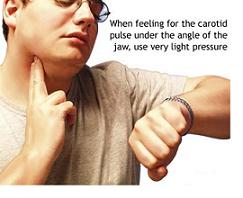|
Get the PulseArticle submission, Thursday 28th February 2008
Last month it was our tongue which we used as a health indicator and now we will try to know some more things about our heart which will directly tell what’s happening inside all of us. PULSE, the rhythm of our body You can check the pulse by holding the inner side upper part at the end of your left palm with index and middle finger of your right hand and feel the pulse in a watch for 15 sec and multiplying it by 4 to get for one minute. [Editors note] Or alternatively by applying a light pressure under the jaw bone against the carotid artery with the index and middle finger of either hand as illustrated in the image above.
Rate–There is no absolute normal. Varies in different individuals and in same individuals under differing circumstances. Adult male 60-80 /min Adult Female 70-90/min Bradycardia is a pulse rate less than 60/min Important note: Both cases are indicative of ill health or the onset of an illness.
Some of the pulse diagnosis are medically not explainable but for us to understand that some thing is wrong, if it's more or less than the range along with some unusually body symptoms it is usually indicator to consult a doctor. Let’s do something for our hearts besides being in love! To strengthen it. And for our rhythm to remains young forever, let’s check our heart. Heart disease and stroke, are the biggest killer of men and women worldwide so all of you gear up. Take up a fitness programme and maintain your target rate. Target heart rates let you measure your initial fitness level and monitor your progress in a fitness programme. This approach requires measuring your pulse periodically as you exercise and staying within 50 to 85 percent of your maximum heart rate. This range is called your target heart rate (HTR).
Your maximum heart rate is about 220 minus your age. The figures above are averages, so use them as general guidelines. When starting an exercise program, aim at the lowest part of your target zone (50 percent) during the first few weeks. Gradually build up to the higher part of your target zone (75 percent). After six months or more of regular exercise, you may be able to exercise comfortably at up to 85 percent of your maximum heart rate. However, you don't have to exercise that hard to stay in shape.
Important note: A few high blood pressure medications lower the maximum heart rate and thus the target zone rate. If you're taking such medicine, call your physician to find out if you need to use a lower target heart rate. Above information is given in good faith however for any diseased condition please consult physician or dietitian before starting it. Your questions and suggestions are welcome at: rena.bill.shukla@gmail.com.

|





